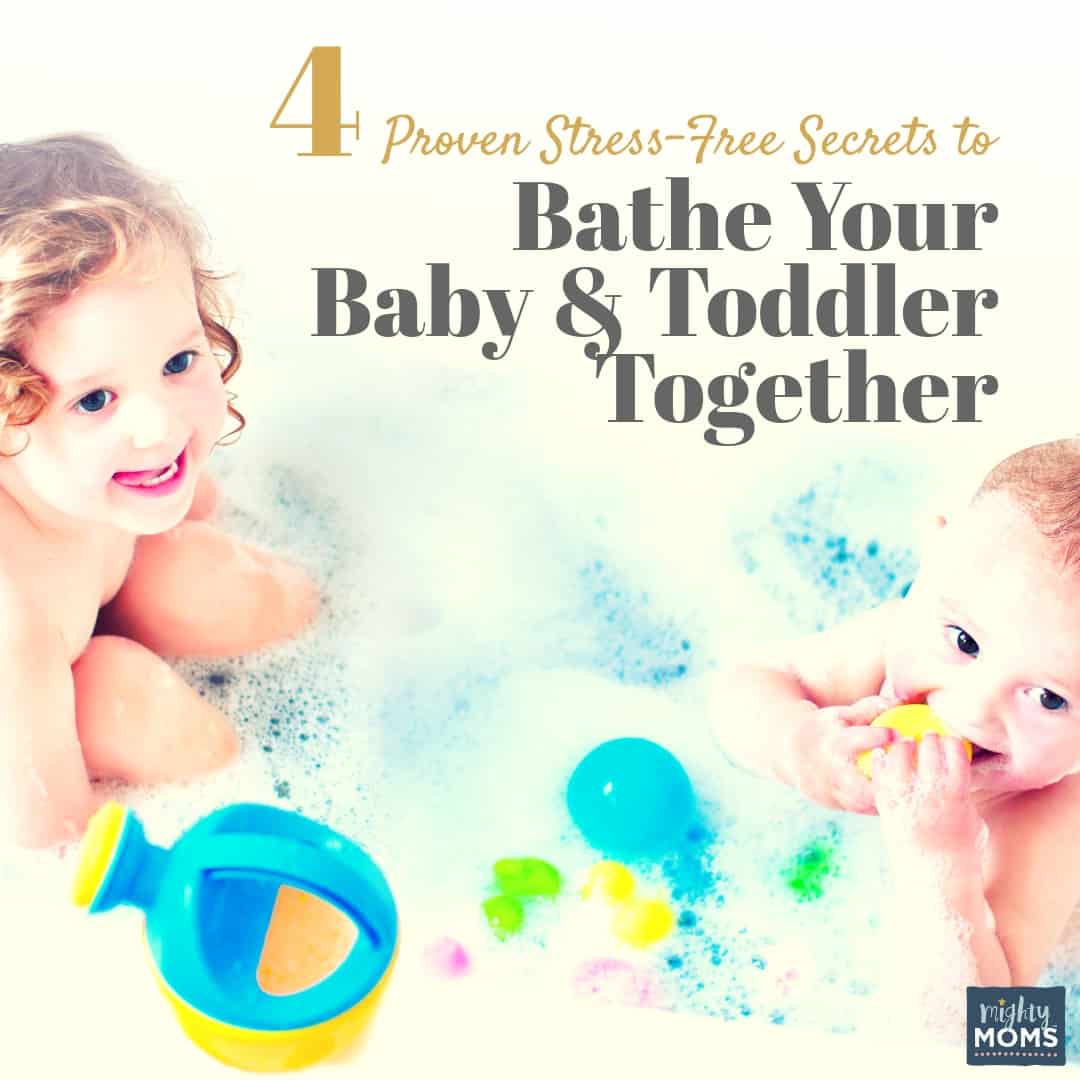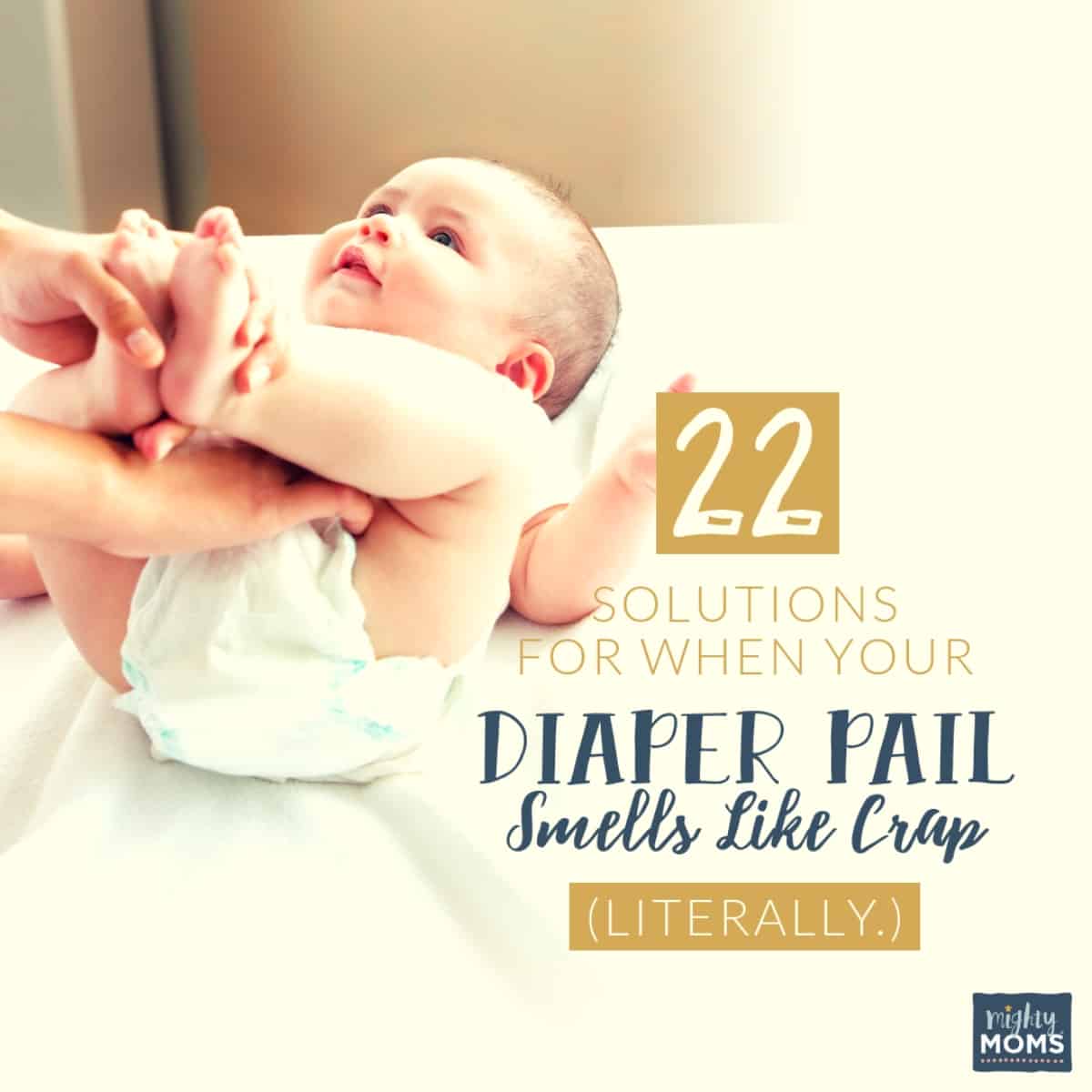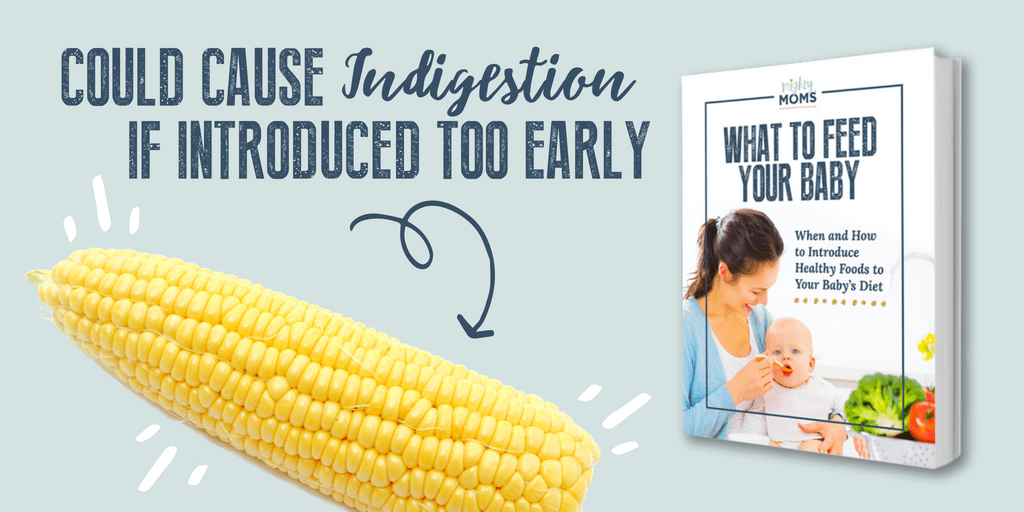In This Article...
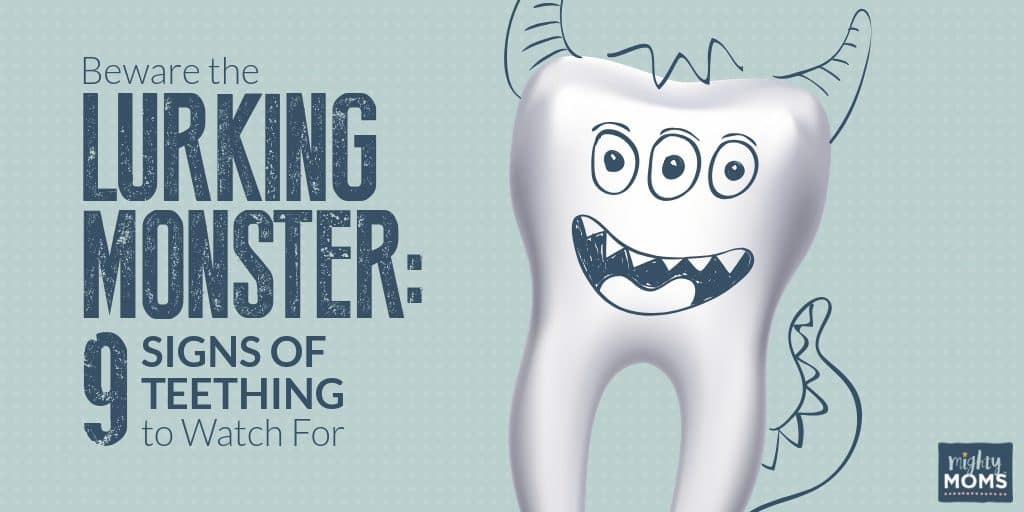
Do you know the signs of teething?
There’s a very good chance that teething is the reason your chubby Dr. Jiggles suddenly transformed to an epic Mr. Hyde monster.
Still…chances aren’t answers. And judging from the fingernail scrapes on the armchair and the wild look in your eyes, you need ANSWERS. As a good friend, who hates to see nice furniture ruined, let me present to you 9 teething signs that will predict a tooth is just over the horizon.
Several Helpful Signs of Teething
- Your baby is drooling buckets.
- She is chewing on everything.
- He has a persistent cough.
- She is abnormally grumpy (or grumpier than usual.)
- He is waking more than normal at night.
- She is tugging on her ear a lot.
- He has little red bumps on his chin and lip. (It’s called impetigo.)
- You can see a little blood blister on her gums.
Obviously, that’s the drooled-down version. Keep reading for more specifics on each of these signs of teething.
Teething Sign #1:
BLOW ME OVER!
I Durn-Darn See a Tooth!
Perhaps the surest of the sure-fire signs of teething is actually seeing a tooth. (You can always count on me to share the tricky tips!)
If this is your baby’s first teething rodeo, start poking your finger around the bottom front and feel for a little ridge.
If this isn’t your first teething rodeo, the chart below will give you a general idea of where to search for the next tooth.
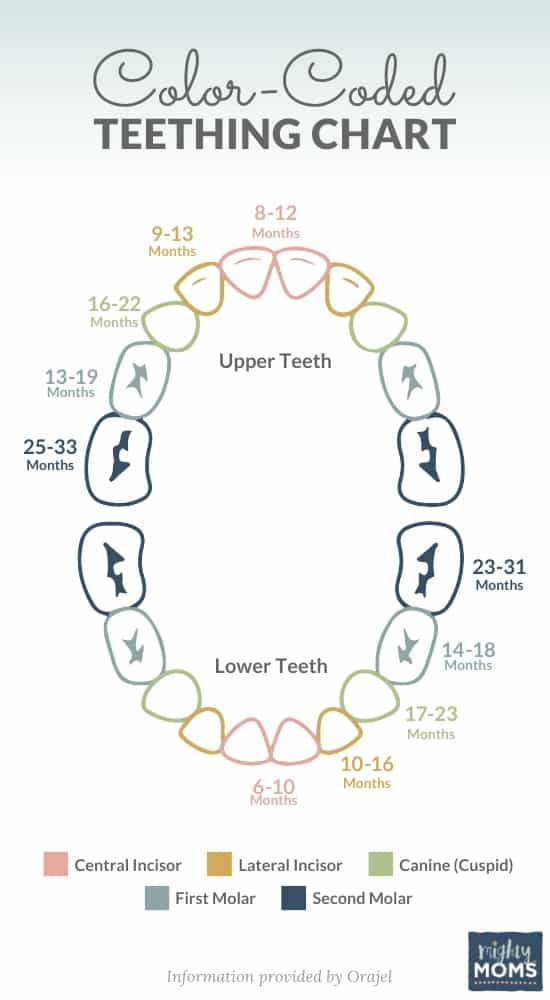
If you don’t feel anything, try to get him to smile REAL-BIG (we have such tough jobs…) and peek at his gums. Swollen and red means a tooth is about to erupt.
Signs of Teething #2:
Buckets ‘O Drool
Drool.
It’s slimy. Sticky. Unpleasant.
Fortunately though for Defendant Drool, it has a helpful purpose that I can actually argue for. Firstly, drool protects those tender gums from the various things he will try to teethe on. (Think: a cushion of saliva.)
Secondly, the antibodies found in drool actually protect him from the evil germs camping out on all the crap he finds to chew on. This is especially comforting when you find him happily gumming the dog toys. (It will happen, friend. Even to the most vigilant of mothers. Thank God for drool…) Accept the inevitable and buy some good drooling bibs. They will absorb the flood and prevent you from having to change his outfit every 2 hours.
There are a few other reasons for excess drooling you should be aware of. If your baby has been drooling like a factory for months and months and isn’t showing any of these other signs of teething, speak to your doctor.
A Deviated Septum
My brother was diagnosed as an adult with a deviated septum…which meant he couldn’t breathe out of his nose as a baby…which meant that his mouth was open constantly…which meant that his salivary glands were in overdrive trying to keep his tongue moist…which explains why he was covered in drool slime like a slug until he was three. Your doctor can do the dirty work of checking your baby’s nose for this.
Blocked Adenoids
Another cause for late droolers are blocked adenoids. Adenoids are close to the sinuses, so if they are blocked, your baby isn’t going to be breathing well out of his nose.
Childhood sleep apnea has been shown recently to be a lot more common than previously thought. Researchers have shared it may be more common than asthma – affecting as many as one child in 10. If your child is older than 9 months and still having significant sleeping issues, check for these sleep apnea signs.
Teething Sign #3:
Chewing. And Chewing.
(And Chewing.)
I swear, I once saw an infant army-crawl herself across the kitchen to a cabinet just so she could chew on the knob.
She looked.
She saw.
She gnawed.
All that effort. All that determination. Just to get that silver knob between her mandibles. (Who knew platinum was so delicious?)
Babies, because they’re so smart, have figured out that chewing is a pain reliever. The tooth is pushing up. So by pushing down, they relieve some of the painful pressure. That’s why you should gather a collection of good (non-knob) teething options like…
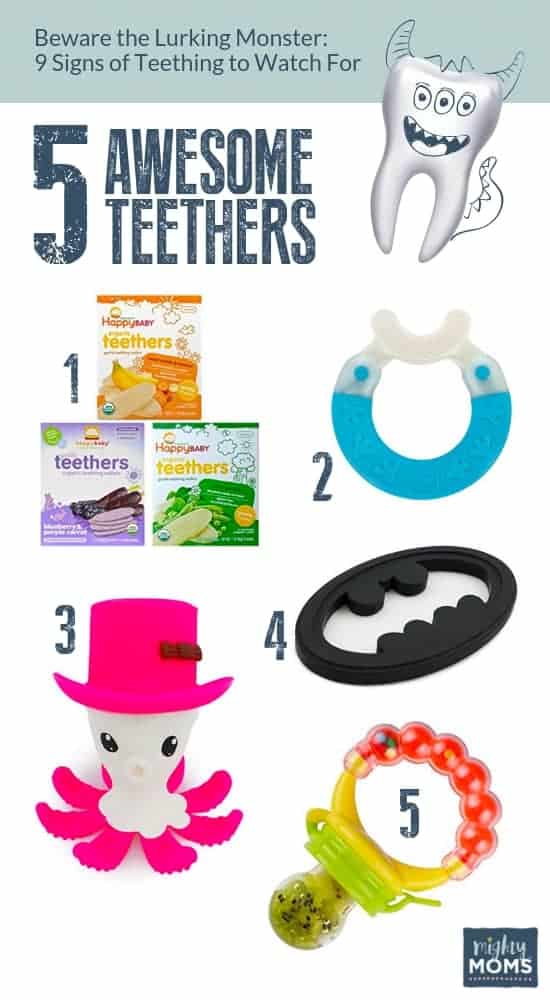
Awesome Baby Teethers Worth Trying
1. Teething Wafers
2. Bite & Brush Teether
3. Otto Octopus
4. Batman Teether
5. Teething Feeder and Rattle
If you’re not a fan of the Sophie Giraffe dog baby chew toy, check out these 10 unique baby teethers other parents have fallen in love with.
Signs of Teething #4:
Constant Coughing
There are three reasons why babies typically cough, but only one is a sure-fire sign of teething. Here’s how to tell the difference between them.
The Allergy Cough
The allergy cough is caused by a runny nose drip drip dripping down the back of your baby’s throat, irritating it. The easiest way to distinguish an allergy from a cold is the color of snot. If it’s clear, he’s allergic to something (usually pollen, dust, or something else airborne). Speak to your doctor about allergy treatment options.
The Cold Cough
The cold cough is accompanied with yellowish, greenish mucus oozing down the back of the throat. This picture of Elena greeting me first thing in the morning will give you an idea of what I’m talking about. (WARNING: SUPER GROSS PICTURE.) You don’t have to watch him suffer from the sidelines.
The Teething Cough
Unlike the allergy and cold coughs above, the teething cough is not caused by the nose drippage. It’s caused by mouth drippage. If his nose is clear and dry as a bone, than the cough is due to drool, and the most probable cause to all that drool is a tooth or two (or four).
Teething Sign #5:
All Hail Queen Crankypants
I always knew when Elena was about to pop a tooth. No, I’m not psychic. I just noticed one very obvious thing:
She got CRANKY.
I’m not talking about the usual occasional “tired and grumpy”. I’m talking about throwing toys, screaming, and looking at me with all the fury a cute munchkin could muster.
There was no pleasing her. If I picked her up, she wanted down. If I put her down, she wanted up. Eating was a nightmare. Sleeping was non-existent.
Honestly, knowing her now as a nine year old, it makes total sense she would react this way. When I get hurt, my first reaction isn’t usually tears. It’s ANGER. So I shouldn’t have been surprised that this little Mini-me reacted to teething in a similar way.
How did I survive the temporary reign of Queen Cranky Pants?
- I deliberately thought about how she was feeling. She has known very little pain up to this point in her little life, and now little teeth are drilling holes in her gums. By thinking of how she was feeling, it helped me get beyond annoyance & frustration and into compassion & understanding.
- I used earplugs. It’s like an out-of-body experience. You hear all the fussing, but it seems far far away… (Get ones with a cord like this one. The loose earplugs are choking hazards.)
- I gave her more teething medications than I gave the other kids. They were easy teethers. She needed more help.
For the sake of your sanity, assume any baby schedule you’ve developed is worthless during and shortly after teething. Whenever your baby doesn’t feel well, it’s going to take some flexibility to get things back on track.
Signs of Teething #6:
Sleep Schmeep
For the babies who are particularly sensitive to teething, sleeping is the usually one of the first things they chuck out the nursery window.
They shift from being Rip Van Winkle to an insomniac zombie within just a few days. It’s a shocking transition.
There are always exceptions! Is your teething baby sleeping more? Congratulations! Enjoy it, sister. If you’re worried it’s too much, pop a call over to your pediatritian.
Normally, parents begin weaning off night feedings and starting to sleep coach between 5 and 6 months old. (As always, any night weaning should be done with the permission of the doctor.)
Ditch that plan during Teething Time. He needs all the comfort he can get. Nurse or bottle feed at 2 am if you have to in order for him to sleep. Sleep and comfort is the name of the teething game. 🙂
Bedtime was also the time you should break out the big guns and offer some kind of medication (OTC or all-natural) for pain management. I go over all those options in this article. Your baby is likely to be more aware of teething pain at night, when he has less distractions.
Teething Sign #7:
The Fake Ear Infection
The nerves under the gums that your baby’s teeth are pushing against travel all the way up the jaw line and behind the ear. Babies (again, because they’re so smart) have discovered that sometimes if they tug on their ear, their mouth will feel better.
Unfortunately, parents often see this and assume these signs of teething are really the signs of an ear infection. So they bundle up little junior, fork over a $30 co-pay, only to hear that the doctor can’t do anything because it’s TEETHING. (Are you reading my bitterness?)
If your baby has these other teething signs, but the ear canal isn’t bright red, save yourself the co-pay and give him a good teether instead.
Signs of Teething #8:
A Rash Beard
Since the Drool Factory is working overtime, spilling over that cute little chin like Niagara Falls, it’s common for babies of both genders to grow a Rash Beard. Little red bumps may start popping out in various beard designs: from the Cowboy Handlebar Mustache to the infamous Iron-Man Goatee.
You can protect against the Rash Beard by slathering on Vaseline or (even better) Aquaphor on his chin and neck. The saliva will slide right on top of his skin without irritating it.
Signs of Teething #9:
Vampire Mouth
Once in a full moon, a little tiny blood blister can form between your baby’s upcoming tooth and the top of his gums. As the tooth moves up, it breaks the bubble, and a little blood will appear in your baby’s mouth.
Yes. It’s freaky.
Fortunately though, since it doesn’t hurt, your baby won’t even notice. (Unless you over-react, in which case expect frightened tears.) Do, however, poke your finger around in there though to make sure it’s a popped teething blood blister and not something else more sinister.
Intrigued? Click here for more weird teething symptoms!
Teething? Pshw!
You’ve Got This.
Teething touches on one of our deepest mothering fears: That our baby will need something and we won’t know how to give it.
Here’s the good news: According to your baby, you’re doing a great job.
Doubt me?
- Do you smile at your baby? Looking at your face has been scientifically proven to increase his serotonin levels – helping him feel more peaceful and relaxed.
- Do you hold your baby close when he starts to cry? Again, studies show that babies held by their mother during shots experience less pain anxiety. Your smell and presence is a comfort when your baby is feeling pain.
- Have you just spent the past 10 minutes reading an article on how to figure out if all this is about teething and how to handle it if it is? That’s a giant A for AWESOME EFFORT, friend.
Teething can be extremely stressful.
…and it can be hard on the baby too.
Personally, Teething Time was consistently one of the hardest parenting stages for me. The lack of sleep. The feelings of helplessness. The trying-everything-but-nothing’s-working.
The key is to keep moving forward. Keep trying things. Experimenting with remedies. The law of averages promises that something is going to work, right? You just have to find your lucky number!
We ♥ honesty! This post contains affiliate links that provide extra money for our mutual coffee habits addictions. Click here to learn more. As an Amazon Associate I earn from qualifying purchases.

